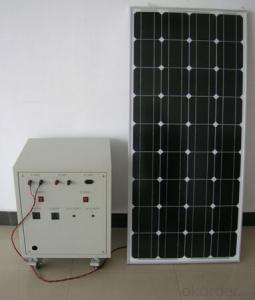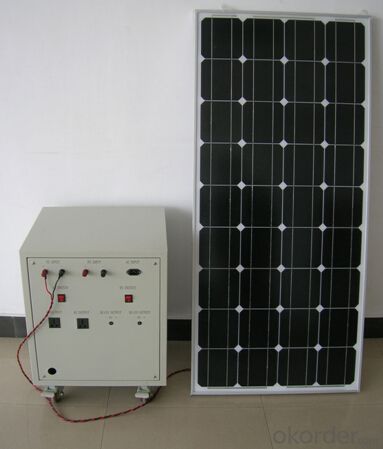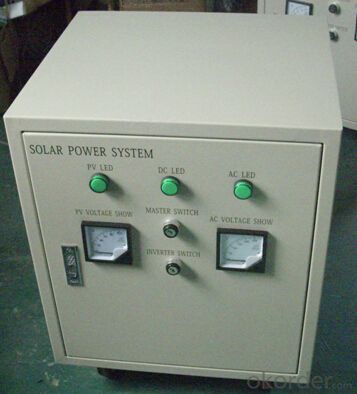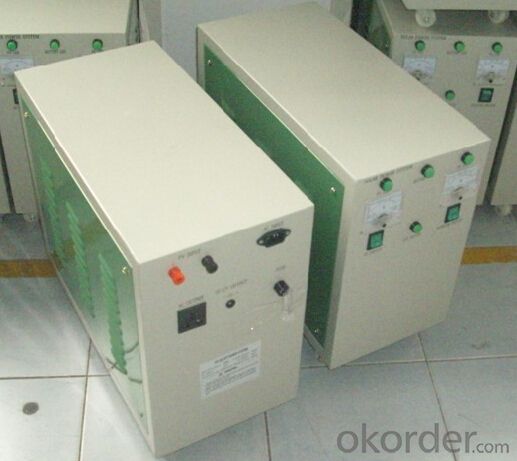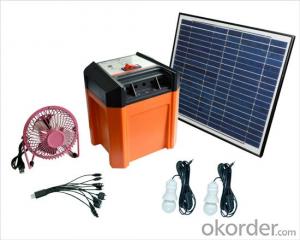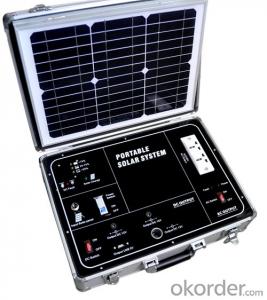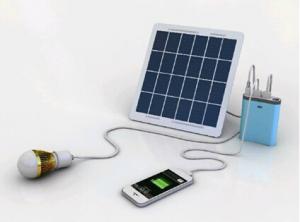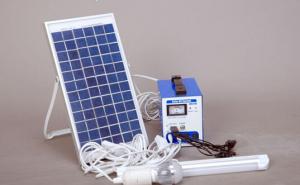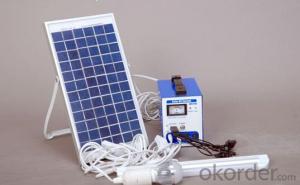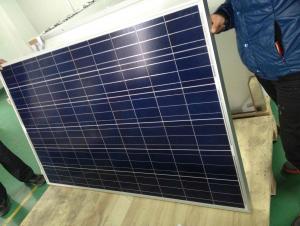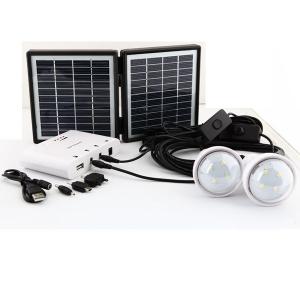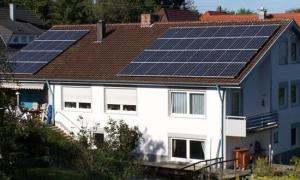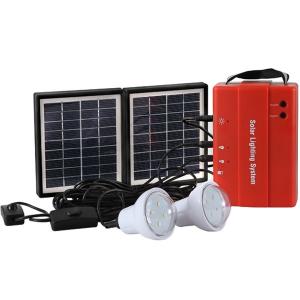Shreveport Residential Solar Energy Systems - CNBM Solar Home System Roof System Easy Installation Capacity-300W
- Loading Port:
- Shanghai
- Payment Terms:
- TT or LC
- Min Order Qty:
- 100 PCS
- Supply Capability:
- 500000 PCS/month
OKorder Service Pledge
OKorder Financial Service
You Might Also Like
Introduction of Solar Energy
In the last two decades, photovoltaics (PV), also known as solar PV, has evolved from a pure niche market of small scale applications towards becoming a mainstream electricity source. A solar cell is a device that converts light directly into electricity using the photoelectric effect. The first solar cell was constructed by Charles Fritts in the 1880s. In 1931 a German engineer, Dr Bruno Lange, developed a photo cell using silver selenide in place of copper oxide. Although the prototype selenium cells converted less than 1% of incident light into electricity, both Ernst Werner von Siemens and James Clerk Maxwell recognized the importance of this discovery. Following the work of Russell Ohl in the 1940s, researchers Gerald Pearson, Calvin Fuller and Daryl Chapin created the crystalline silicon solar cell in 1954. These early solar cells cost 286 USD/Watt and reached efficiencies of 4.5–6%. By 2012 available efficiencies exceed 20% and the maximum efficiency of research photovoltaics is over 40%.
Introduction of Solar Home System
Solar Home System is composed by Solar Panels, Inverters, Charger Controller, Battery, Cable, Mounting Bracket, which is applied to produce electricity for home use.
Solar Home System is quite suitable product in urban area and the place which is short of electricity. As the cost of solar products reduced, more and more family can bear the charge of solar products. These products apply to schools, hospitals, public halls and private housing, communication stations, weather station. Also can use as household appliances, lighting, communications equipment, meteorological equipment.
Our company’s main target is to make every family can use cheap solar energy and enjoy the new innovation of modern science and technology.
Picture of Our Factory

Working Principle of Solar Home System
This is an off-grid solar system which uses batteries to store the solar energy, at the same time, the solar system can be connected with the grid for utilization of grid power. The solar system uses battery power in priority, but when sunshine is not so good or loads consumption is too big which caused the battery power inadequacy, then the system can switch automatically to grid power supply. Meanwhile, the system can charge the batteries with grid power until batteries are fully charged. Then the solar system will switch back to battery power supply.
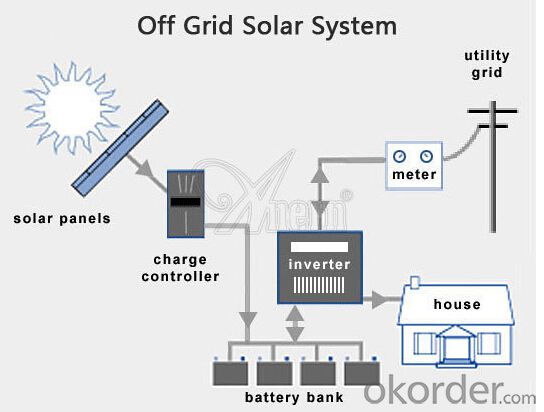
Product Details of Solar Home System
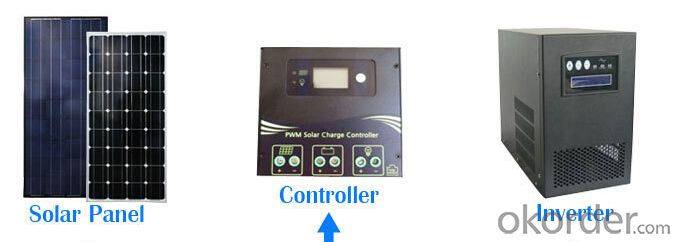
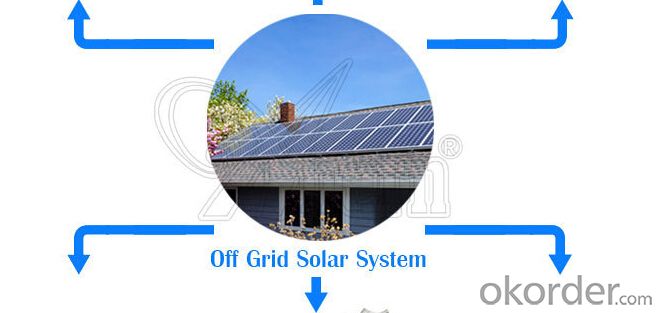

Specification of Solar Home System
Technical data: | |||||||||
Inverter | Rated load power | 1000W | |||||||
Output wave | Pure sine wave | ||||||||
Input voltage | 24V | ||||||||
Output voltage | DC:12V | ||||||||
Output frequency | 50HZ/60HZ | ||||||||
Precision of output frequency | ±6% | ||||||||
Solar panel | Pmax | 150W*2PCS | |||||||
Vmp | 36V | ||||||||
Imp | 8.34A | ||||||||
Charger | Charger voltage & current | 24V/20A | |||||||
Battery | Capacity | 12V100AH*2PCS | |||||||
Power box | Spray paint iron box,with input,output, ammeter,voltmeter,master switch and so on. | ||||||||
Package data: | |||||||||
Part | Size (L*W*H mm) | Weight (kg) | 20' (pcs) | 40' (pcs) | |||||
Power box | 580*520*540 | 60 | 84Sets | 200Sets | |||||
Solar panel | 1500*700*90 | 24 | |||||||
Solar panel bracket |
|
| |||||||
Loading electrical equipment(For consult) | |||||||||
Name of Load | Power(W) | Quantity | Working Time per Day (H) | Working Days | |||||
Color TV | 65W | 1 | 6 | 3 days | |||||
Satellite TV Receivers | 25W | 1 | 6 | 3 days | |||||
lamp | 11W | 2 | 8 | 3 days | |||||
Other | 150W |
| 2 | 3 days | |||||
Advantage of Our Solar Home System
1 Excellent Performance: Our Solar Home System is composed by Brand Standard Kits with high quality. Our solar system has the advantage of high efficiency and stable operation. We can ensure our product with a long life period.
2. Small Orders Accepted: We can accept small orders as our customer’s trial order.
3. Guarantee/Warranty: We supply 10 Years Product Warranty and 25 Years Performance warranty.
4. Warehouse: We have warehouse overseas which can bring great convenience to our customer to pick up the products.
FAQ
Q: You are a manufacturer or Trader?
A: We are a Group corp. with 1GW capacity, which is Okorder’s registered VIP Supplier, enjoy Okorder’s Financial Guarantee.
Q: Required mainly certificates (CE&IEC/TUV/RoHS)?
A: Our products are certificated by CE RoHS, IEC, C-tick etc.
Q: Your main exported market is?
A: Main markets of our products is: South-east Asia, Mid-east, Arica, East Europe and Latin America.
- Q: Can solar energy systems be used in areas with high rainfall?
- Yes, solar energy systems can be used in areas with high rainfall. While excessive rainfall may temporarily reduce the amount of sunlight reaching the solar panels, modern solar technologies are designed to generate electricity even in low light conditions. Additionally, solar energy systems can still produce electricity during cloudy or rainy days, although at a slightly reduced efficiency compared to sunny days. Therefore, solar energy systems can still be effectively utilized in areas with high rainfall.
- Q: What are the devices needed for PV systems?
- Solar photovoltaic power generation system is mainly composed of solar cell matrix, controller, battery, inverter and other equipment
- Q: Can a solar energy system store excess energy for later use?
- Yes, a solar energy system can store excess energy for later use. This is achieved through the use of batteries or other storage technologies. When a solar energy system generates more electricity than is needed in real-time, the excess energy can be stored in batteries. These batteries can then be used to power the system during periods of low solar generation, such as at night or during cloudy days. By storing excess energy, solar energy systems can provide a more reliable and continuous power supply, reducing the dependence on the grid and increasing self-consumption of renewable energy.
- Q: Can solar energy systems be used in areas with limited financial resources?
- Yes, solar energy systems can be used in areas with limited financial resources. These systems have become increasingly affordable and accessible over the years, with various financing options and government incentives available to support their installation. Additionally, solar energy can help reduce electricity bills in the long run, providing a cost-effective and sustainable energy solution for communities with limited financial resources.
- Q: Can solar energy systems be used in areas with limited space?
- Yes, solar energy systems can be used in areas with limited space. There are various options available such as rooftop solar panels, solar carports, and even solar-powered windows, which can effectively harness solar energy in compact spaces. Additionally, advancements in technology have led to the development of smaller and more efficient solar panels, allowing for installation in areas with limited surface area.
- Q: What happens to excess energy generated by a solar energy system?
- Excess energy generated by a solar energy system can be stored or sold back to the grid. When a solar energy system produces more electricity than is being consumed, the excess energy can be stored in batteries for later use. This stored energy can be utilized during times when the solar panels are not generating enough electricity, such as during nighttime or cloudy days. Alternatively, if the solar energy system is connected to the electrical grid, the excess energy can be fed back into the grid. This process is known as net metering. In net metering arrangements, the excess energy is fed into the grid, and the owner of the solar system receives credit for the electricity they provide. This credit can then be used to offset the electricity consumed from the grid when the solar panels are not generating enough power. By either storing excess energy or selling it back to the grid, solar energy systems ensure that no energy goes to waste. This not only maximizes the efficiency and utilization of solar power but also allows solar energy system owners to benefit financially from their excess generation.
- Q: Can solar energy systems be used for powering electric bus charging stations?
- Yes, solar energy systems can be used for powering electric bus charging stations. Solar panels can be installed on the rooftops of the charging stations or in nearby areas to capture sunlight and convert it into electricity. This electricity can then be used to charge the batteries of electric buses. The energy generated by solar panels is clean, renewable, and sustainable, making it an ideal choice for powering electric bus charging stations. Additionally, using solar energy reduces dependence on fossil fuels and helps to mitigate greenhouse gas emissions, making it an environmentally friendly solution.
- Q: Are there any risks of electrical arcing with solar energy systems?
- Solar energy systems have inherent risks of electrical arcing. This occurs when insulation in electrical components breaks down, causing electricity to flow through non-conductive materials like air. The consequences can be hazardous, including fire and damage to the system. There are several factors that can lead to electrical arcing in solar energy systems. Faulty wiring, loose connections, and damage to solar panels are common culprits. These issues increase the likelihood of electrical arcing, which can result in overheating, component melting, and even fires. To mitigate these risks, it is crucial to have qualified professionals install and maintain the solar energy system in accordance with industry standards and regulations. Regular inspections and maintenance are necessary to identify and address potential issues that could cause electrical arcing. In addition, using high-quality electrical components and implementing proper grounding techniques can help reduce the risk of electrical arcing. Safety measures such as circuit breakers, surge protectors, and arc fault circuit interrupters (AFCIs) can provide further protection against electrical arcing. In conclusion, while solar energy systems have many benefits, it is important to be mindful of the risks of electrical arcing. By ensuring proper installation, maintenance, and adherence to safety guidelines, these risks can be minimized, allowing for the safe and efficient operation of solar energy systems.
- Q: Can a solar energy system be installed in areas with high seismic activity?
- Yes, a solar energy system can be installed in areas with high seismic activity. However, it is crucial to ensure that the system is designed and installed to withstand the potential impacts of seismic events. Several measures can be taken to enhance the system's resilience, such as: 1. Reinforced Mounting Structures: Solar panels are typically mounted on structures, such as rooftops or ground-mounted frames. These structures should be designed to withstand seismic forces, including the possibility of ground shaking. Reinforced materials and additional bracing can be used to make the mounting structures more robust. 2. Flexible Wiring and Connectors: Solar panels are connected through wiring, and special consideration should be given to the installation of flexible wiring and connectors. This allows for some movement during seismic events, reducing the risk of damage or disconnection. 3. Secure Panel Installation: Solar panels should be securely fastened to the mounting structures to prevent them from dislodging during an earthquake. Additional measures, such as using specialized clamps or adhesives, can be taken to enhance the panel's stability. 4. Proper Grounding: Ensuring proper grounding of the system is essential to protect against electrical surges and potential damage caused by seismic events. It is important to follow local electrical codes and guidelines to ensure the system is safely grounded. 5. Regular Inspections and Maintenance: Regular inspections should be conducted to identify any potential issues or damage to the solar energy system. Prompt maintenance and repairs can help mitigate any risks associated with seismic activity. By following these guidelines and working with experienced professionals, a solar energy system can be successfully installed and operated in areas with high seismic activity.
- Q: How do solar energy systems impact the electricity pricing structure?
- Solar energy systems have a significant impact on the electricity pricing structure as they reduce the demand for traditional electricity from the grid. This decrease in demand puts downward pressure on electricity prices, benefiting consumers. Additionally, solar energy systems often generate excess electricity that can be sold back to the grid, further lowering prices. Overall, solar energy systems help to stabilize and lower electricity prices, making them more affordable for everyone.
Send your message to us
Shreveport Residential Solar Energy Systems - CNBM Solar Home System Roof System Easy Installation Capacity-300W
- Loading Port:
- Shanghai
- Payment Terms:
- TT or LC
- Min Order Qty:
- 100 PCS
- Supply Capability:
- 500000 PCS/month
OKorder Service Pledge
OKorder Financial Service
Similar products
Hot products
Hot Searches
Related keywords
